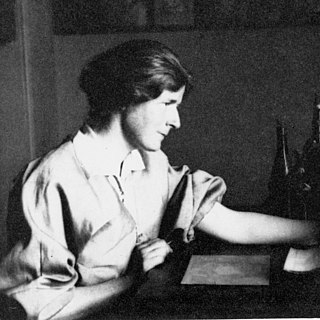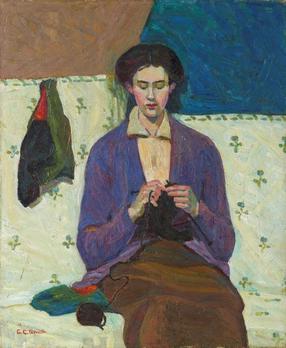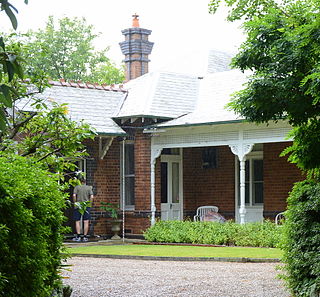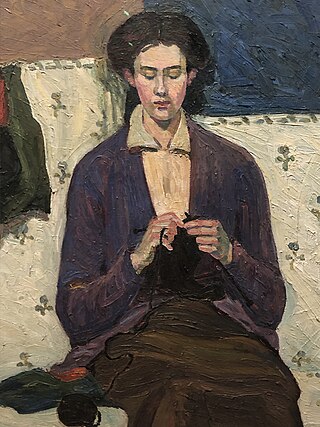
The National Gallery of Australia (NGA), formerly the Australian National Gallery, is the national art museum of Australia as well as one of the largest art museums in Australia, holding more than 166,000 works of art. Located in Canberra in the Australian Capital Territory, it was established in 1967 by the Australian Government as a national public art museum. As of 2022 it is under the directorship of Nick Mitzevich.

Ethel Campbell Louise Anderson was an early twentieth century Australian poet, essayist, novelist and painter. She considered herself to be mainly a poet, but is now best appreciated for her witty and ironic stories. Anderson has been described as "a high-profile author, artist, art commentator and emissary for modernism".

Margaret Rose Preston was an Australian painter and printmaker who is regarded as one of Australia's leading modernists of the early 20th century. In her quest to foster an Australian "national art", she was also one of the first non-Indigenous Australian artists to use Aboriginal motifs in her work.

Grace Cossington Smith was an Australian artist and pioneer of modernist painting in Australia and was instrumental in introducing Post-Impressionism to her home country. Examples of her work are held by every major gallery in Australia.
Grace Adela Williams Crowley was an Australian artist and modernist painter.
Roy De Maistre CBE was an Australian artist of international fame. He is renowned in Australian art for his early experimentation with "colour-music", and is recognised as the first Australian artist to use pure abstraction. His later works were painted in a figurative style generally influenced by Cubism. His Stations of the Cross series hangs in Westminster Cathedral and works of his are hung in the Tate Gallery, London and in the Art Gallery of New South Wales, Sydney.
Norah Simpson was an Australian modernist painter. She grew up in Sydney and is described as "giving impetus to modernism" in Australia: when returning from France in 1913, she brought back a series of reproductions of then-current works which were influential to her fellow art students. Sydney-based modernists inspired by those works and Simpson's descriptions of techniques include Grace Cossington Smith, Roy de Maistre and Roland Wakelin.

Clarice Marjoribanks Beckett was an Australian artist and a key member of the Australian tonalist movement. Known for her subtle, misty landscapes of Melbourne and its suburbs, Beckett developed a personal style that contributed to the development of modernism in Australia. Disregarded by the art establishment during her lifetime, and largely forgotten in the decades after her death, she is now considered one of Australia's greatest artists.

Makinti Napanangka was a Pintupi-speaking Indigenous Australian artist from Australia's Western Desert region. She was referred to posthumously as Kumentje. The term Kumentje was used instead of her personal name as it is customary among many indigenous communities not to refer to deceased people by their original given names for some time after their deaths. She lived in the communities of Haasts Bluff, Papunya, and later at Kintore, about 50 kilometres (31 mi) north-east of the Lake MacDonald region where she was born, on the border of the Northern Territory and Western Australia.

Jessie Constance Alicia Traill was an Australian printmaker. Trained by Frederick McCubbin at the National Gallery of Victoria Art School, and by painter and printmaker Frank Brangwyn in London, Traill worked in England and France in the period immediately preceding World War I. During the war she served in hospitals with the Voluntary Aid Detachment.
Roland Wakelin was a New Zealand-born Australian painter and teacher.

Constance Stokes was an Australian modernist painter who worked in Victoria. She trained at the National Gallery of Victoria Art School until 1929, winning a scholarship to continue her study at London's Royal Academy of Arts. Although Stokes painted few works in the 1930s, her paintings and drawings were exhibited from the 1940s onwards. She was one of only two women, and two Victorians, included in a major exhibition of twelve Australian artists that travelled to Canada, the United Kingdom and Italy in the early 1950s.

Dorothea Foster Black was an Australian painter and printmaker of the Modernist school, known for being a pioneer of Modernism in Australia. In 1951, at the age of sixty, Black was killed in a car crash.

The Sock Knitter is a 1915 painting by the Australian artist Grace Cossington Smith. The painting depicts a woman, believed to be the artist's sister, knitting a sock. It was the first work by Cossington Smith to be exhibited and has been "acclaimed as the first post-impressionist painting to be exhibited in Australia."
The figure is pressed forward onto the picture plane. Tightly constructed. The creamy impasto paint of the backgrounds holds the picture together. The sitter then holds the background together. Like a jigsaw. She is the pattern maker. There are echoing triangles everywhere.

Cossington is a heritage-listed residence located at 43 Ku-Ring-Gai Avenue, in the Sydney suburb of Turramurra in the Ku-ring-gai Council local government area of New South Wales, Australia. It was designed by Nixon and Allen and built in 1899. It is also known as Sylvan Fells and Sylvan Falls. The property is privately owned. It was added to the New South Wales State Heritage Register on 18 August 2006.
William Frater (1890–1974) was a Scottish-born Australian stained-glass designer and modernist painter who challenged conservative tastes in Australian art.

Australian modernism, similar to European and American modernism, was a social, political and cultural movement that was a reaction to rampant industrialisation, associated moral panic of modernity and the death and trauma of the World Wars.

Arnold Joseph Victor Shore was an Australian painter, teacher and critic.

Barbara Nancy Brash was a twentieth-century post-war Australian artist known for her painting and innovative printmaking. In an extensive career she contributed to the Melbourne Modernist art scene, beside other significant women artists including: Mary Macqueen, Dorothy Braund, Anne Marie Graham, Constance Stokes, Anne Montgomery (artist) and Nancy Grant.
The Australian Academy of Art was a conservative Australian government-authorised art organisation which operated for ten years between 1937 and 1946 and staged annual exhibitions. Its demise resulted from opposition by Modernist artists, especially those associated with the Contemporary Art Society, though the influence of the Academy continued into the 1960s.














